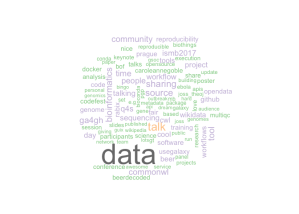Chains of amino acids strung together make up proteins and since each amino acid has a 1-letter abbreviation, we can find words (English and otherwise) in protein sequences. I imagine this pursuit began as soon as proteins were first sequenced, but the first reference to protein word-finding as a sport is, to my knowledge, “Price’s Protein Puzzle”, a letter to Trends in Biochemical Sciences in September 1987 [1].
Price wrote:
It occurred to me that TIBS could organise a competition to find the longest word […] contained within any known protein sequence.
The journal took up the challenge and published the winning entries in February 1988 [2]. The 7-letter winner was RERATED, with two 6-letter runners-up: LEADER and LIVELY. The sub-genre “biological words in protein sequences” was introduced almost one year later [3] with the discovery of ALLELE, then no more was heard until 1993 with Gonnet and Benner’s Nature correspondence “A Word in Your Protein” [4].
Noting that “none of the extensive literature devoted to this problem has taken a truly systematic approach” (it’s in Nature so one must declare superiority), this work is notable for two reasons. First, it discovered two 9-letter words: HIDALGISM and ENSILISTS. Second, it mentions the technique: a Patricia tree data structure, and that the search took 23 minutes.
Comments on this letter noted one protein sequence that ends with END [5] and the discovery of 10-letter, but non-English words ANNIDAVATE, WALLAWALLA and TARIEFKLAS [6].
I last visited this topic at my blog in 2008 and at someone else’s blog in 2015. So why am I here again? Because the Aho-Corasick algorithm in R, that’s why!
Continue reading →


 July 21-22 saw
July 21-22 saw 